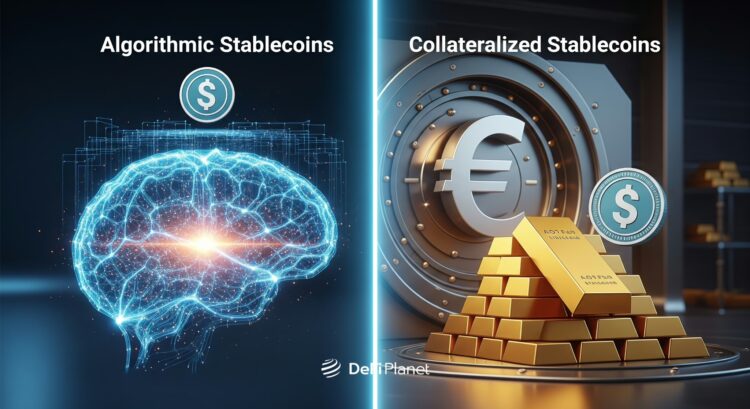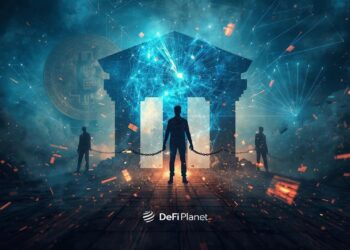In crypto, stablecoins are the closest thing to \”safe\”, or so we like to believe. Designed to hold steady amid market chaos, stablecoins have become the financial glue of DeFi, powering everything from lending protocols to cross-border payments. But not all stablecoins are created equal.
On one side of the ring, you have algorithmic stablecoins cleverly coded, reserve-free assets that balance themselves through supply and demand logic. On the other hand, stand collateralized stablecoin tokens backed by real assets like fiat or crypto, offering a sense of solidity in a volatile market. Both models aim for the same goal: stability. Yet, their paths couldn’t be more different.
One relies on mathematics, while the other depends on finances. One promises decentralization; the other requires trust. And as the collapse of TerraUSD reminded the world, getting this balance wrong can have catastrophic consequences.
In this article, we unpack the core mechanics, pros, cons, and risk profiles of both models, so you can better understand how these digital lifelines work and which might weather the next storm.
What are Algorithmic Stablecoins?
Algorithmic stablecoins are a type of digital asset engineered to maintain a stable value most often pegged to a fiat currency, such as the U.S. dollar—without relying on traditional collateral. Rather than being backed by reserves of fiat or crypto assets, they rely on smart contracts and algorithms that automatically regulate supply in response to market demand.
So, how do algorithmic stablecoins maintain their peg? When the stablecoin trades above its target price, the protocol increases the supply to push the price down. Conversely, when the price falls below the peg, the supply is reduced to drive it back up. This self-correcting mechanism is designed to stabilize the coin\’s value without external backing.
A well-known example is TerraUSD (UST), which once stood as the leading algorithmic stablecoin before its collapse. It operated using a dual-token model with LUNA, where LUNA was used to absorb volatility and help UST maintain its peg to the US dollar. Another example is Ampleforth (AMPL), which uses a “rebase” system. Instead of adjusting the market supply broadly, AMPL changes the number of tokens held in individual wallets depending on price movements expanding when prices are high and contracting when prices are low.
RELATED: Understanding Algorithmic Stablecoins With Ampleforth
These examples highlight the diverse mechanisms through which algorithmic stablecoins aim to enforce stability without relying on collateralized reserves.
Market Response Post Terra Luna Collapse
The collapse of Terra in May 2022 marked a turning point for the stablecoin market, arguably its most dramatic and cautionary tale. TerraUSD (UST), once the flagship of algorithmic stablecoins, lost its $1 peg in a downward spiral that wiped out over $40 billion in value. In a desperate attempt to restore the peg, the network flooded the market with LUNA tokens, triggering hyperinflation and accelerating the downfall.
RELATED: Terra LUNA 99% Crash: How Did It All Go Wrong?
The aftermath sent shockwaves through the crypto ecosystem. Investors reeled, and global regulators took notice, sounding alarms about the systemic risks posed by uncollateralized or partially collateralized models. Projects like Frax Finance quickly adjusted course, abandoning their partial algorithmic frameworks in favour of fully collateralized approaches to restore user confidence.
In the wake of the turmoil, stablecoin market dominance consolidated around centralized players like USDT and USDC names seen as safer due to their transparent reserve models and regulatory compliance.
The Terra debacle underscored a hard truth in crypto: confidence is everything. Once it’s broken, even the most innovative mechanisms can unravel overnight.
What are Collateralized Stablecoins?
Now, what are collateralized stablecoins? Collateralized stablecoins are digital assets whose value is supported by reserves of real-world or crypto-based assets. This backing ensures that each stablecoin is anchored by tangible value, providing a layer of trust and stability for users. These stablecoins generally fall into two main categories: fiat-collateralized stablecoins and crypto-collateralized stablecoins.
Fiat-collateralized stablecoins are backed by traditional currencies such as the U.S. dollar, which are held in reserve by a centralized entity. In contrast, crypto-collateralized stablecoins are backed by other cryptocurrencies and are often over-collateralized to cushion against the high volatility typical of crypto markets.
Is USDT a collateralized stablecoin? The answer is yes; USDT is a collateralized stablecoin, backed primarily by fiat and short-term securities.. On the other hand, DAI, created by MakerDAO, is a leading example of a crypto-collateralized stablecoin that uses decentralized governance and over-collateralization to maintain its peg.
Collateralization helps maintain price stability by offering a redemption mechanism: each stablecoin can, in theory, be exchanged for an equivalent amount of its backing asset. This reserve-backed model builds user confidence, provided the reserves are sufficient, transparent, and regularly audited.
READ ALSO: Gold-Backed vs. USD-Backed Stablecoins: A Comparative Overview
Key Differences Between Algorithmic and Collateralized Stablecoins
Mechanism of Price Stabilization
Algorithmic stablecoins maintain their value by automatically increasing or decreasing supply in response to market demand. This is done through smart contracts without relying on external assets. In contrast, collateralized stablecoins use actual reserves, such as fiat or crypto assets to keep their value stable, providing a more direct method of price control.
Collateral Backing vs. Algorithmic Adjustments
Collateralized stablecoins are backed by tangible assets, offering a clear and verifiable foundation for their value. This makes them easier to understand and often more trusted by users. Algorithmic stablecoins, however, use complex code-based systems to simulate stability, which can be innovative but also expose users to higher risk in times of volatility or system breakdowns.
Transparency and Trust Model
Collateralized stablecoins typically enhance trust by offering third-party audits and public disclosures of their reserves, assuring users of their solvency. In contrast, algorithmic stablecoins often operate in a more opaque manner, with their mechanisms and code harder to verify or audit, which can lead to doubts about their long-term reliability.

Pros and Cons of Algorithmic Models
Algorithmic stablecoins come with a unique set of advantages. For starters, they don’t require massive reserves sitting in bank vaults; just smart contracts and clever code. This makes them more capital-efficient and theoretically more decentralized, operating entirely on-chain without the need for intermediaries. Their structure also allows for rapid scalability, since there’s no need to manage physical assets or fiat backing as demand grows.
But these benefits come with serious trade-offs. Their peg mechanisms are often fragile, if public confidence wavers, the system can unravel quickly, as the TerraUSD collapse vividly demonstrated. Their underlying models are complex, making them difficult for the average user to fully grasp. This lack of understanding can fuel panic when prices swing.
In theory, algorithmic stablecoins are elegant and efficient. In practice, they walk a tightrope one misstep, and the whole system can come crashing down.

Pros and Cons of Collateralized Stablecoins
Collateralized stablecoins have carved out a stronghold in the crypto space for one key reason: they’re backed by something real. Whether it’s fiat currency sitting in a bank account or crypto held in smart contracts, this tangible asset backing gives users confidence that their coins have actual value behind them. For fiat-backed coins like USDC or USDT, reserve disclosures and third-party audits offer an extra layer of transparency that builds trust, especially crucial in a market where sentiment can shift overnight.
However, this stability often comes at a cost. Fiat-collateralized models tend to rely on centralized entities, introducing the very risks of censorship, mismanagement, or regulatory clampdowns that crypto was designed to avoid. On the other hand, crypto-backed stablecoins try to keep things decentralized but often require over-collateralization to protect against volatility. That means locking up $150 worth of crypto to mint $100 in stablecoins an inefficient use of capital that limits broader adoption.
In essence, collateralized stablecoins offer peace of mind through real-world backing, but they must balance trust, decentralization, and efficiency three forces that don’t always play nicely together.

In Conclusion, Which One Can You Really Trust?
The truth is there’s no one-size-fits-all answer. It all comes down to what matters most to you. If your heart beats for decentralization and censorship resistance, algorithmic stablecoins might align with your ideals. But tread carefully: their track record in high-stress environments is shaky at best, and their peg mechanisms can unravel quickly under pressure.
On the other hand, if you’re after stability, predictability, and wide adoption, collateralized stablecoins, especially fiat-backed ones like USDC and USDT, offer a more reassuring option. They’re trusted by institutions, supported by audits, and generally hold their value well. Still, they come with their own baggage: centralization risks, regulatory exposure, and the ever-present question of whether those reserves are truly secure.
Neither model is flawless. Algorithmic coins need to prove they can survive panic without collapsing. Collateralized coins must work toward greater transparency and reduce reliance on centralized custodians. As the ecosystem matures, we may see innovative hybrid approaches emerge marrying decentralization with tangible backing.
Until then, the best approach is cautious optimism. Whether you’re a DeFi developer, investor, or curious user, remember the golden rule of crypto: Don’t trust—verify. Diversify. And never stop asking hard questions.
Disclaimer: This piece is intended solely for informational purposes and should not be considered trading or investment advice. Nothing herein should be construed as financial, legal, or tax advice. Trading or investing in cryptocurrencies carries a considerable risk of financial loss. Always conduct due diligence.
If you want to read more market analyses like this, visit DeFi Planet and follow us on Twitter, LinkedIn, Facebook, Instagram, and CoinMarketCap Community.





















